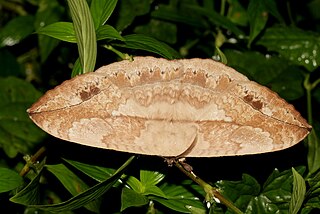
Orgyia is a genus of tussock moths of the family Erebidae. The genus was described by Ochsenheimer in 1810. The species are cosmopolitan, except for the Neotropical realm.

Nola is a genus of moths described by William Elford Leach in 1815. They are the namesake of the subfamily Nolinae and the family Nolidae. This genus occurs worldwide wherever suitable habitat is present.

The Lasiocampinae are a subfamily of the moth family Lasiocampidae. The subfamily was described by Thaddeus William Harris in 1841.

Hypena is a genus of moths in the family Erebidae. It was first described by Franz von Paula Schrank in 1802. These non-migratory moths overwinter as pupae and almost never estivate as adults.

Amata is a genus of tiger moths in the family Erebidae. The genus was erected by Johan Christian Fabricius in 1807.
Phaos is a genus of moths in the family Erebidae from Australia. The genus was described by Francis Walker in 1855.

Lymantria is a genus of tussock moths in the family Erebidae. They are widely distributed throughout Europe, Japan, India, Sri Lanka, Myanmar, Java, and Celebes. The genus was erected by Jacob Hübner in 1819.

Metasia is a genus of moths of the family Crambidae.

Catephia is a genus of moths of the family Erebidae. Most species of this genus are found in Africa.
Cropera is a genus of moths in the subfamily Lymantriinae. The genus was erected by Francis Walker in 1855.

Crorema is a genus of moths in the subfamily Lymantriinae. The genus was erected by Francis Walker in 1855.

Euproctis is a genus of tussock moths in the family Erebidae described by Jacob Hübner in 1819. Species are cosmopolitan, widespread throughout Palearctic, African, Oriental and Australian regions. Molecular phylogenetic studies indicate that the genus as presently understood comprises a large number of unrelated lineages, only a few of which have names, and is therefore in serious need of revision.

Laelia is a genus of tussock moths in the family Erebidae. The genus was described by Stephens in 1828. Species are well distributed throughout Europe, Japan, China, India, Sri Lanka, Myanmar and Java.
Beralade is a genus of moths in the family Lasiocampidae first described by Francis Walker in 1855.

Pterolocera amplicornis is a moth of the family Anthelidae. It was described by Francis Walker in 1855. It is found in Australia.
Pterolocera ferruginea is a moth of the Anthelidae family. It was described by Strand in 1926. It is found in Australia.

Eupterote is a genus of moths in the family Eupterotidae. It was first described by Jacob Hübner in 1820.

Doratifera is a genus of cup-moth caterpillars in the family Limacodidae. The genus was erected by James Duncan in 1841. There are about 13 described species in Doratifera, found primarily in Australia. They are called cup-moths because of the shape of their cocoons. In the species Doratifera vulnerans, the venon has a complex structure having 151 different protein-based toxins produced from 59 distinct protein families. The venom can be used in pesticides and drugs.














